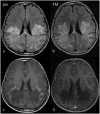B cell depletion can be effective in multiple sclerosis but failed in a patient with advanced childhood cerebral X-linked adrenoleukodystrophy
- PMID: 31452685
- PMCID: PMC6696829
- DOI: 10.1177/1756286419868133
B cell depletion can be effective in multiple sclerosis but failed in a patient with advanced childhood cerebral X-linked adrenoleukodystrophy
Abstract
Rituximab exerts its clinical efficacy by its specific pattern of depletion of CD20+ B lymphocytes and it has been demonstrated that rituximab is an effective treatment for relapsing remitting multiple sclerosis. X-linked adrenoleukodystrophy (X-ALD), the most common monogenetic neuroinflammatory disorder, shares substantial overlap with multiple sclerosis in the neuropathological changes found in brain tissues in advanced stages of the disease. While there is no effective therapy for these patients, we hypothesized that rituximab might be effective in arresting the neuroinflammatory process. Our detailed clinical, imaging and immunological data revealed that rituximab is not effective in advanced stages of X-ALD and consequently should not be applied for compassionate use in these patients.
Keywords: B cells; X-ALD; X-linked adrenoleukodystrophy; multiple sclerosis; rituximab.
Conflict of interest statement
Conflict of interest statement: H. Rosewich and S. Nessler report no conflict of interest. W. Brück has received honoraria for lectures by Bayer Vital, Biogen, Merck Serono, Teva, Genzyme, Roche and Novartis. He is a member of scientific advisory boards for Teva, Biogen, Novartis and Genzyme, and receives research support from Teva, Biogen, Genzyme and Novartis. J. Gärtner has received honoraria for lectures and consultancy fees from Bayer, Teva and Novartis and research support from Novartis.
Figures


Similar articles
-
Depletion of B lymphocytes from cerebral perivascular spaces by rituximab.Arch Neurol. 2009 Aug;66(8):1016-20. doi: 10.1001/archneurol.2009.157. Arch Neurol. 2009. PMID: 19667224
-
Clinical stabilization and effective B-lymphocyte depletion in the cerebrospinal fluid and peripheral blood of a patient with fulminant relapsing-remitting multiple sclerosis.Arch Neurol. 2005 Oct;62(10):1620-3. doi: 10.1001/archneur.62.10.1620. Arch Neurol. 2005. PMID: 16216948
-
Metformin-induced mitochondrial function and ABCD2 up-regulation in X-linked adrenoleukodystrophy involves AMP-activated protein kinase.J Neurochem. 2016 Jul;138(1):86-100. doi: 10.1111/jnc.13562. Epub 2016 Mar 14. J Neurochem. 2016. PMID: 26849413
-
Childhood X-linked adrenoleukodystrophy: clinical-pathologic overview and MR imaging manifestations at initial evaluation and follow-up.Radiographics. 2005 May-Jun;25(3):619-31. doi: 10.1148/rg.253045118. Radiographics. 2005. PMID: 15888613 Review.
-
[X-linked adrenoleukodystrophy].Ann Endocrinol (Paris). 2007 Dec;68(6):403-11. doi: 10.1016/j.ando.2007.04.002. Epub 2007 May 29. Ann Endocrinol (Paris). 2007. PMID: 17532287 Review. French.
Cited by
-
Inflammation and Immunomodulation in Cerebral X-linked Adrenoleukodystrophy: Review of Pathology and Interventions.J Child Neurol. 2025 Jul 23:8830738251353034. doi: 10.1177/08830738251353034. Online ahead of print. J Child Neurol. 2025. PMID: 40696909 Free PMC article.
References
-
- Steinberg SJ, Moser AB, Raymond GV. X-Linked Adrenoleukodystrophy. In: Pagon RA, Adam MP, Ardinger HHet al. (eds) GeneReviews(R). Seattle: University of Washington, 1993. - PubMed
-
- Miller WP, Rothman SM, Nascene Det al. Outcomes after allogeneic hematopoietic cell transplantation for childhood cerebral adrenoleukodystrophy: the largest single-institution cohort report. Blood 2011; 118: 1971–1978. - PubMed
-
- Cartier N, Hacein-Bey-Abina S, Bartholomae CCet al. Lentiviral hematopoietic cell gene therapy for X-linked adrenoleukodystrophy. Methods Enzymol 2012; 507: 187–198. - PubMed
Publication types
LinkOut - more resources
Full Text Sources

